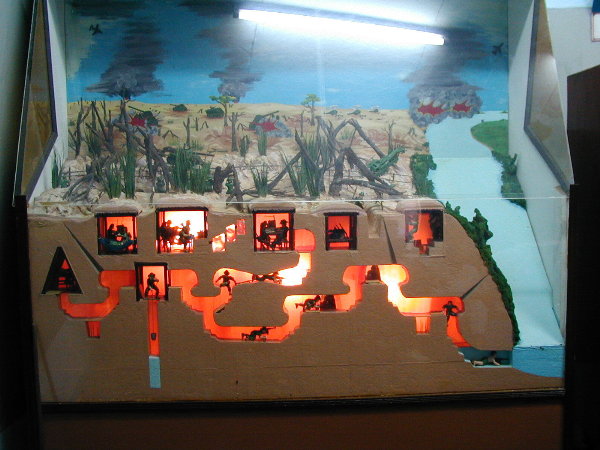Can the SAF fight in tunnels?
-
The US failed in tunnel warfare when they could not clear the Viet Cong from the 200 km of tunnels in Cu Chi. Can the great SAF do better?

The tunnels extended for 200 km drom Cu Chi to Saigon
entrance to tunnel complex
underground kitchen
Getting into tunnel to fight -
wow so cool... me want dat secretly somewhere as my base

-

Tunnel with underwater entrance.......how to fight this enemy? -
knn.Originally posted by Dr Who:
Tunnel with underwater entrance.......how to fight this enemy?
i seriously want to make tis kind of secret base for myself
-
We release man-eating gophers.
-
...Originally posted by Alvin.Yeoh:We release man-eating gophers.
does it realli exist ? -
The tunnels are actually pitch dark without lights.......and too small for big sized Americans too move......
Model of family in tunnel....
Tunnel entrance.....invisible when trap door is covered. -

Pretty gal in tunnel........in truth the tunnels are dark, damp, full of bats and giant spiders.....and booby traps that can poke your balls with bamboo stakes
Shiit is poured on top of stakes to make it poisonous....
Punji Stakes -


 1st look at thread tittle i thought ts meant fight in KPE
1st look at thread tittle i thought ts meant fight in KPE 
-
The tunnels did not go completely unnoticed by U.S. officials. They recognized the advantages that the NLF held with the tunnels, and accordingly launched several major campaigns to search out and destroy the tunnel system. Among the most important of these were Operation Crimp and Operation Cedar Falls.
Operation Crimp began on January 7, 1966, with B-52 bombers dropping 30-ton loads of high explosive effectively turning the once lush jungle into a pockmarked moonscape. Eight thousand troops from the U.S. 1st Infantry Division, 173rd Airborne Brigade, and the 1st Battalion, Royal Australian Regiment combed the region.
The operation was, for the most part, unsuccessful. On the occasion when troops found a tunnel, they would often underestimate its size. Rarely would anyone be sent in to search the tunnels, as it was so hazardous. Besides being too small for most Western men to fit through, the tunnels were often rigged with explosive booby traps or punji stake pits. The two main responses in dealing with a tunnel opening were to flush the entrance with gas or water to force the guerillas into the open, or to toss a few grenades down the hole and “crimp” off the opening. The clever design of the tunnels along with the strategic use of trap doors and air filtration systems rendered American technology ineffective.
From : http://en.wikipedia.org/wiki/Cu_Chi_Tunnels -
So.......Will the great SAF be defeated by these simple tactics?
-
I was thinking along the lines of MRT tunnels...Originally posted by sand king:

 1st look at thread tittle i thought ts meant fight in KPE
1st look at thread tittle i thought ts meant fight in KPE 

-
Originally posted by wonderamazement:I was thinking along the lines of MRT tunnels...


-
SAF to form Tunnel rats? Hmmm...unlikely...

-
yes but that only means the entrance are blocked and they will dig their way up. inside is air not water leh.Originally posted by Alvin.Yeoh:We release man-eating gophers.
anyway liddat how to get ventilation?
-
Well, these are specially trained Gophers meant to hunt their prey in the tunnels. Ta da!
-
Those with claustrophobia (i.e. a lot of people) won't dare enter. The entrance looks incredibly tiny.
-
How bout we set up perimeters around it, their resources are limited, in there. How long can they last?
Constantly smoke em from their entrances? One easy smoke is the one used to kill mozzies, they sure buay tahan one

-
cover all the ventilation

-
Ventilation shaft very close to the firing post leh, very risky. But everything is risky in war..


-
look like earthworms
-
I wonder who will build this kind of tunnels in today's scenario and where will this be built? Johore? Batam?


-
i don't know about our neighbors, but we can get bangalas to dig 4 us.....Originally posted by sgdiehard:I wonder who will build this kind of tunnels in today's scenario and where will this be built? Johore? Batam?


-
Its not easy to uncover all these ventilation vents as they are camouflaged.Originally posted by popikachu:cover all the ventilation
-
our superior airforce will bomb the damn tunnels and our elite infantry troops will kill our enemies as each of us can take on a 100.
we heard you callin'
callin' in for us
we are from
a hardcore infantry!